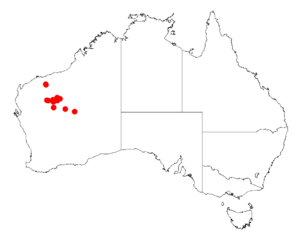Acacia intorta facts for kids
Quick facts for kids Acacia intorta |
|
|---|---|
| Scientific classification | |
| Genus: |
Acacia
|
| Species: |
intorta
|
 |
|
| Occurrence data from AVH | |
Acacia intorta is a type of shrub or small tree. It belongs to the Acacia family. This plant is special because it only grows in the dry, central parts of Western Australia. It was first described in 1983 by Bruce Maslin.
About the Acacia intorta
This unique plant is often called a wattle. It has a twisted, gnarled look. It usually grows to be about 1.5 to 3 meters (5 to 10 feet) tall. Its bark is gray, rough, and has cracks.
What It Looks Like
The main branches of the Acacia intorta are often twisted. They tend to spread out sideways. The smaller branches are smooth. Its leaves are called phyllodes. They are straight and usually round, like a pencil. These leaves are stiff and have a sharp point. They are about 5 to 10 centimeters (2 to 4 inches) long. They are also about 1.5 to 2 millimeters wide. You can see many faint lines on them.
Flowers and Seeds
The Acacia intorta blooms from April to June. It produces bright yellow flowers. These flowers grow in spikes that are 1 to 5 centimeters (0.4 to 2 inches) long. The flowers are not packed together very tightly. After flowering, the plant grows seed pods. These pods are narrow and oblong. They are about 4 to 9 centimeters (1.6 to 3.5 inches) long. They are also about 5 to 8 millimeters wide. Inside the pods are dark brown seeds. The seeds are shaped like an oval or oblong. They are about 4 to 7 millimeters long.
Where It Grows
This plant is found in the Pilbara and Goldfields areas of Western Australia. Most of these plants grow between Meekatharra and Newman. You can find them on rocky ridges and steep slopes. They also grow on flat, salty areas where water drains. The Acacia intorta likes to grow in soils that contain calcrete. These soils are often alkaline, meaning they are not acidic.

